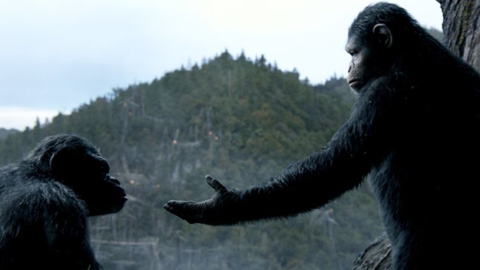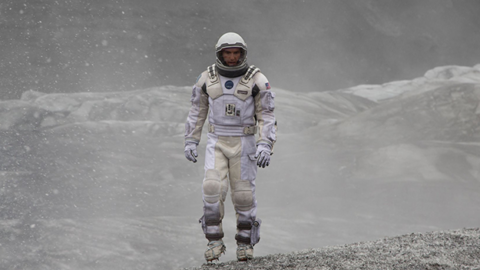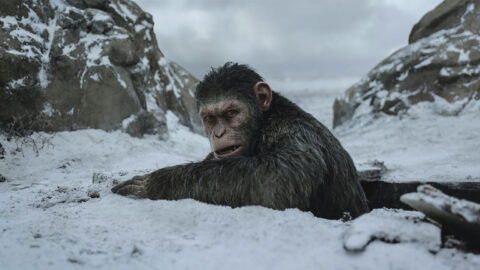Film of the Week: War for the Planet of the Apes
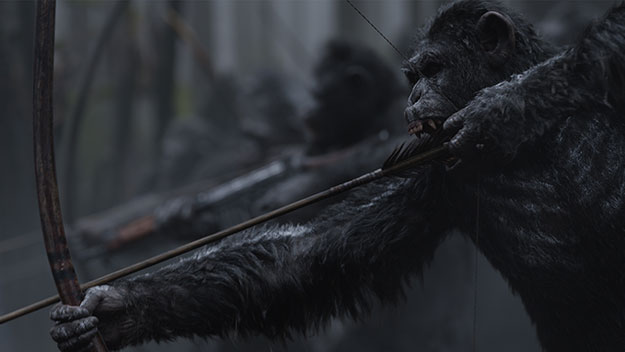
“My God,” says Woody Harrelson’s Colonel, gazing into the eyes of alpha chimpanzee Caesar in War for the Planet of the Apes, “look at your eyes—they look almost human.” It’s a line laden with ironic meaning, given that “human” isn’t likely to sound like a compliment to the leader of the species that’s about to make homo sapiens obsolete on earth. But the comment also derives an ironic charge from the film’s visual execution: Caesar’s eyes are consistently alive, expressive, while the Colonel’s, when not hidden by cobalt blue aviator shades, are often reduced to pools of ominous dark, occasionally lit by a feral gleam.
Of course, the Harrelson character is also delivering a commentary on the technical brilliance of Matt Reeves’s film. Caesar’s eyes are indeed uncannily eloquent. The potency of the Planet of the Apes relaunch trilogy (beginning in 2011 with Rupert Wyatt’s Rise of…) lies in the unprecedented effectiveness of its CGI, which makes these apes walk, talk, and emote like no screen primate before—certainly not the latex-faced creatures of the original ’60s-’70s Planet of the Apes series, however nostalgic we may feel about them.
I don’t often swoon over CGI in movies these days, but the last episode, Dawn of the Planet of the Apes, also directed by Reeves (I missed Wyatt’s series opener), had a distinct air of revelation. It was largely to do with the apparent miracle of performance capture, which uses data from an actor’s body and face and essentially “decants” their physical being—their soul, if you want to see it that way—into a digitally constructed artificial body. Thanks to these techniques, Dawn’s various apes—including Caesar, played by Andy Serkis, and the warlike Koba, played by Toby Kebbell—felt more unnervingly autonomous than pretty much any similar VFX attempts to create convincing life-forms.
If War for the Planet of the Apes arguably pushes this achievement even further, it’s not just thanks to performance capture but also because of the extraordinary sensitivity to texture apparent in the work of studio Weta Digital and the team led by visual effects supervisor Dan Lemmon and Joe Letteri (credited as Senior Visual Effects Supervisor). It’s become a cliché to say that the old caveat about CGI—that you couldn’t adequately simulate hair and fur—no longer applies, but War for the Planet of the Apes reminds us of that breakthrough in no uncertain terms. Here you get fur you almost think you can touch: from the matted surface of a shaggy gorilla to the softer, thinner tufts that stand out around a chimp’s face in chiaroscuro, not forgetting the delicate way that single raindrops fall on Caesar’s shoulders. When digital cinema captures texture as sensuously and as precisely as this, a film can be a treat not just for blockbuster adepts but for the most rarefied aesthetes too.
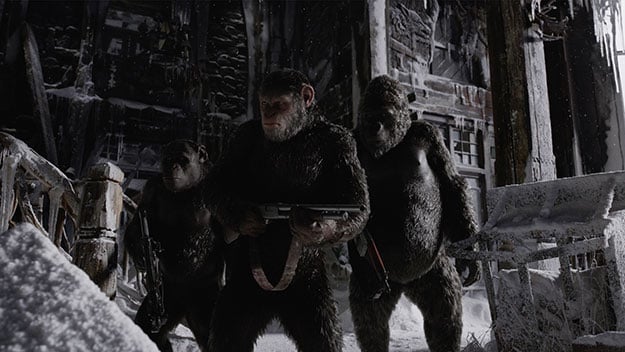
These effects can carry genuine meaning, too: the scene in which orangutan Maurice (performed by Karin Konoval) and a young human girl (Amiah Miller) face each other in close-up acquires real emotional depth, not just from the surfaces of the leathery-textured moon face that houses the orangutan’s melancholy eyes, but also from the narrow focus shooting that brings out the rough textures of the child’s woolly jacket.
There, I’ve said it: “real emotional depth,” and in a CGI spectacle. This itself is surely some kind of barrier broken, and other moments in War for the Planet of the Apes which pack similar dramatic clout—such as a poignant last encounter between Caesar and the Colonel, as we realize that humanity’s die is cast. The new trilogy seems to have hit an elusive sweet spot in restoring emotion to the cinema of spectacle through the image itself, and it’s largely to do with the creation of its hybrid creatures, apes who are somewhat like humans, while being still a lot like apes. The primates’ characterful presence in Dawn of the Planet of the Apes made you feel that the humans, headed by Jason Clarke, were merely a bland support act, but War for the Planet of the Apes redresses that balance by introducing a human villain, played by Harrelson, so savage that the animal-human opposition plays out to much more vital effect.
War for the Planet of the Apes is a pretty satisfying close to the trilogy, given the running time of 150 minutes; clever as this film is, it can’t sustain its narrative for that long. That it contains brilliance doesn’t finally make it a brilliant film; the current spate of VFX spectacles gives you the sense of occasionally being treated to glimpses of the Sublime, but individual films rarely offer deeper consistent pleasures.
As such films go, War for the Planet of the Apes scores highly on intensity and intelligence, but not on originality, nor would it claim to—and not just because it’s a reboot of a dusty old property that itself originated in a French novel. Just as the cycle’s premise is all about ancestry, War for the Planet of the Apes too constantly flaunts its own filmic DNA. Most obviously, it’s a Vietnam movie in disguise. Its human soldiers are first seen advancing through deep jungle with slogans daubed on their helmets—BEDTIME FOR BONZO, ENDANGERED SPECIES—echoing those we’ve seen in many a ’60s news photo. Late in the film, a piece of combat action plays to a slow passage of Michael Giacchino score seemingly tailored to resemble similar elegiac moments in The Deer Hunter and Platoon. Harrelson’s Colonel—with the phallic bald skull of Brando in Apocalypse Now, plus a tense Dennis Hopper fold between the eyebrows—lurks in his HQ to the sounds of Hendrix’s “Hey Joe.” He’s Coppola’s Kurtz redux—a point that we would have got for ourselves even without the graffiti reading (well, duh), “APE-POCALYSPE NOW” (War of the Planet of the Apes is typical of a cinema that routinely assumes its audience is fairly smart, but not quite smart enough).
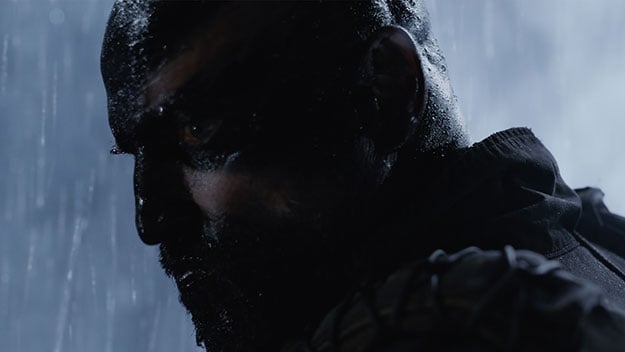
Those are not the only movie echoes. A Western-style horseback chase through snow leads to an abandoned lodge that’s the Overlook Hotel on the outside, a snow palace from Doctor Zhivago (or perhaps Edward Scissorhands) within. Among a plethora of quite beautiful landscape shots, a dazzling image of pink blossom against snow suggests that Reeves and DP Michael Seresin have been looking at artfully colored Asian spectacles like Zhang Yimou’s House of Flying Daggers (a hail of arrows is right out of the same director’s Hero). And threaded throughout are touches of the Hollywood historical/Biblical genre: Caesar variously resembles Spartacus, Jesus, and Moses leading his people to the Promised Land (there’s a weirdly apt closing of the circle here, as the hairy savior finally steps into the sanctified sandals of Charlton Heston—who was also star of the original 1968 Planet of the Apes).
All this gives War a certain thematic density, while making it feel curiously lacking in a fresh discourse of its own. The conflicting themes make it hard to grasp what the film might really be about; so many possible subtexts are programmed in that it somehow feels a matter of little consequence whether we read War as an indirect commentary on revolution, the end of slavery, the history of American warfare, whatever. The contemporary allusions seem almost cursorily thrown in: the Colonel is, guess what, building a wall, and the apes are gonna pay for it (in enforced labor). The only subtext that produces a freshly disturbing ring is the Colonel’s belief that he’s waging a “holy war” and his conviction in the inevitability of a terrible showdown, to which all history has been leading: suddenly we see him as an apocalypse nut in the Steve Bannon mold.
The film’s real USP is surely its creation of apes who seem real—yet, not real. It’s surely the gap between the primate bodies and the human expressions that allow these hybrid creations to vault the famously challenging “Uncanny Valley” of artificial beings and register as organically real in themselves. They still feel unsettling, however, and it’s notable how little the leading apes act like apes, and how much like humans (they don’t spend much time picking each other’s fleas, for example, or practicing bonobo-style free love). It’s still somehow cartoonish when an ape speaks English, although for those that who don’t, the film has some fun with subtitles (“Ee! Ee! Ee!” goes baby Cornelius; “Father!” reads the translation). And Maurice uses sign language as if performing interpretative dance moves, beautifully. It’s perhaps these primates’ inherent human characteristics that allows us to buy into talking animals in the first place (although reportedly the same effect works beautifully with other creatures in the recent The Jungle Book, which I haven’t seen).
If Caesar stands out in these films as the absolute king of the swingers, it’s precisely because of his eyes, which stand out on screen because they’re lighter than those of the other apes. But oddly, his skin is lighter too, making him stand out as a “white” character among predominantly black crowds. This is bizarre, given that the series’s liberation theme is couched in visual language that partly borrows from Black Power—the apes’ two-fisted salute resembles that movement’s raised fist, but the implicit equation of enslaved apes with black people, and the idea that they require a white general to lead them to freedom, suggest contradictions wildly at odds with the film’s overt meaning.
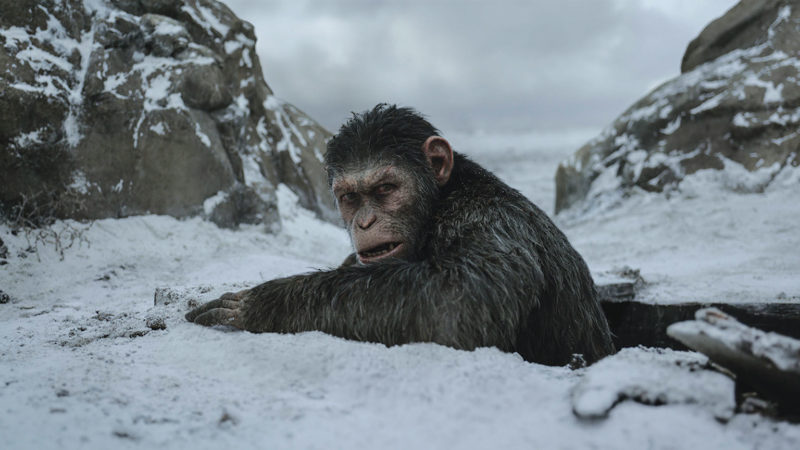
Fitting uncomfortably into this overall pattern is “Bad Ape,” played by Steve Zahn—a talking chimpanzee raised in a zoo and taught to see himself in essentially abject terms, although he emerges as a rebel and trickster. He’s also a hook for younger viewers, leavening the prevalent grimness with comic relief in the traditional style of the “funny monkey.” Bad Ape has big anxious eyes, pouting lips that actually look like a chimp’s mouth as opposed to the other apes’ set scowl, and a general demeanor between anxious nerd-child and cranky old man. When he first appears, the variety and plasticity of Bad Ape’s expression had me thinking that here was the most eloquent breakthrough in digital characterization since Serkis’s own Gollum in the Rings series (disappointingly, Serkis’s Caesar, so eloquent in Dawn of the Planet of the Apes, doesn’t get to stray too much here beyond a careworn, bellicose frown). Zahn’s performance—or the digital transcription of it—is virtuoso but the film doesn’t ultimately know what to do with Bad Ape, proving that characterization isn’t, alas, the same as character. In the end, Bad Ape doesn’t rise much above the level of a Jar Jar Binks—and we know what uncomfortable racial undertones he brought with him.
Reeves is smart enough not to fall into that trap. One trap he does fall into, however, is to make this film so unrelentingly masculine. Apart from human child Nova—embodying vulnerability and, as her name suggests, renewal—and female apes who feature somewhat peripherally here, played by Judy Greer and Sara Canning, the film is a very male affair, unless you note that Maurice, a male orangutan possessed of “feminine” thoughtfulness and empathy, is played, very affectingly, by Karin Konoval. However, in the year of Wonder Woman, this makes War of the Planet of the Apes look somewhat incongruously butch. Still, maybe there’s a further sequel yet to be made, in which we meet the Amazon she-gibbons of Themyscira.
Jonathan Romney is a contributing editor to Film Comment and writes its Film of the Week column. He is a member of the London Film Critics Circle.



